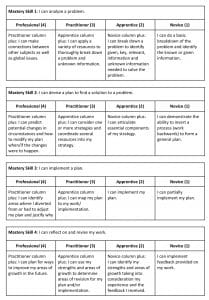A Mastery-Based Math Teacher’s Journey, Part 4 – Embracing Problem-Solving and Further Refining Mastery Skills
CompetencyWorks Blog

This is the final post in a four-part series by Ashley Ferrara about her ongoing journey to develop a mastery-based approach to teaching mathematics. She is a teacher and interim acting assistant principal at the Academy for Software Engineering in New York City, a member school of the Mastery Collaborative.
We’ve covered a lot of territory over the three blog posts. In the first post, we explored my not-so-positive initial reaction to the shift to mastery based learning, my first mastery skill (and its limitations), and the “aha!” moment that mathematics repeats itself. The second post described how I approached the mathematics content that did not repeat itself, and the third post documented my evolution to mostly year-long skills that were assessed repeatedly throughout the year.
I also left you with a question at the end of the last blog: “Ten years from now, what skill or skills do you want your students to still have from your class?” I was asked this during a professional development session at school a few years ago, and to say my answer surprised me would be an understatement! I wanted students to walk away from my class with stronger comprehension, communication, and problem-solving skills so they were prepared for life after high school.
Clearly my response has nothing to do with Algebra 1 content. Solving an equation or graphing a line were the furthest from my mind when asked. At the time I was asked this question, my advisees—a group of 14 students I had met with daily from their first day of freshman year to the day they graduated—had graduated a year earlier and most had just finished their first year of college. During that year, I had fielded so many questions from them about how different college was, how difficult some of their classes were, and how unprepared they felt. Unfortunately, this resulted in some of them taking a break from college after their first semester. I just kept thinking, “What could I have done differently to prepare them better? What could we as a school have done?”
The questions I was (and still am) asking are huge, complex questions. Just like with mastery-based learning, I am never going to pop out of a cake and tell you I’ve been hiding the answer from you this whole time and all you have to do is follow my simple instructions. During the current and past school year, my way of addressing these big questions was to remove all content-specific language from my mastery skills and rubrics.
Wait…what? Yes, you read it right. I removed all content-specific language from my mastery skills.
Mastery skills are the pillars of your curriculum. They guide what you teach, how you teach, and what you assess. So if I wanted students 10 years from now to have stronger comprehension, communication, and problem-solving skills as a result of being in my class, then I needed my pillars (mastery skills) to reflect that. In a math department meeting, my co-worker brought up Polya’s Problem Solving Techniques, and they became the inspiration behind my (millionth?) mastery skill revision. Here are my current mastery skills:

I know, I took a BIG turn right at the end of this series of blog posts! However, I felt it was important to reflect my authentic mastery journey, which has gone through a lot of changes across a relatively short amount of time. The new mastery skills have, again, shifted how I teach, what I teach, and how I assess. While it’s been difficult to shift yet again, I am very excited about what’s happened so far.
Prior to making this shift, I asked myself, “Am I really ready to do this? Can this work with my content?” I mapped out a few ideas for what each skill could look like in my classroom, which I’m going to share in the hopes that it may spark some ideas for your classroom.
Overall: My clearest vision for how these skills would come to life in the classroom is that they would be taught holistically, always. During class, we would dive deeply into one rich problem, and cycle through each of the mastery skills within that problem. The content would be taught through the problems we were tackling as a class.
Mastery Skill 1: I can analyze a problem.
- When working on this skill, students annotate, define the unknown(s), clarify what they are being asked to do, define key vocabulary words, etc.
Mastery Skill 2: I can devise a plan to find a solution to a problem.
- When working on this skill, students create a plan of attack for reaching the solution. This can include creating a step-by-step list of how they will reach the solution, locating and citing resources such as anchor charts or previous lessons with models of how to complete the work, practicing a new method that has been presented to them that would help solve the problem, etc.
Mastery Skill 3: I can implement a plan.
- When working on this skill, students follow their very detailed plan. This part of the problem-solving process also helps students identify possible missteps or holes in their plans, perhaps when they run into a “mathematical roadblock.” This is also a great place to push students to try to find a different strategy to arrive at the solution (e.g., how many unique ways can you isolate that variable?)
Mastery Skill 4: I can reflect on and revise my work.
- When working on this skill, students implement feedback from teachers, peers, and themselves. This skill is visited often, and it is a back and forth between Mastery Skills 2, 3, and 4, as students revise their plan based on issues they run into while implementing it. This is also the time when students assess the validity of their solution (e.g., if you’re being asked how many tickets were sold, is “-47” a reasonable solution?)
As I wrap up this blog series, I hope that my reflections on my own mastery journey have resonated with you and possibly given you some clarity or ideas about what this could look like in your own practice. Over the years, I have found that talking about mastery-based learning and learning what others are doing has impacted and inspired my work the most. Please know that if you want to continue the conversation or see a blog post or webinar diving into one or more areas of this series in deeper detail, you can email me at [email protected]! Best of luck with this school year!
Learn More:
- A Mastery-Based Math Teacher’s Journey, Part 1 – Initial (mis)Steps and the “Aha!” Moment
- A Mastery-Based Math Teacher’s Journey, Part 2 – Refining Mastery Skills and Assessment Strategies
- A Mastery-Based Math Teacher’s Journey, Part 3 – Moving Away From “Covering” Everything
 Ashley Ferrara is a founding faculty member at the Academy for Software Engineering (AFSE), a public high school in New York City. She joined AFSE nine years ago and was an Early Career Fellow and Master Teacher with Math for America for seven of those years. After earning a bachelor’s degree in accounting from the University of Connecticut and working with a big-four accounting firm, she earned master’s degrees in mathematics education from Teachers College, Columbia University and educational leadership and administration from Bank Street College of Education. She also graduated from the New York City Department of Education’s Leaders in Education Apprenticeship Program (LEAP).
Ashley Ferrara is a founding faculty member at the Academy for Software Engineering (AFSE), a public high school in New York City. She joined AFSE nine years ago and was an Early Career Fellow and Master Teacher with Math for America for seven of those years. After earning a bachelor’s degree in accounting from the University of Connecticut and working with a big-four accounting firm, she earned master’s degrees in mathematics education from Teachers College, Columbia University and educational leadership and administration from Bank Street College of Education. She also graduated from the New York City Department of Education’s Leaders in Education Apprenticeship Program (LEAP).